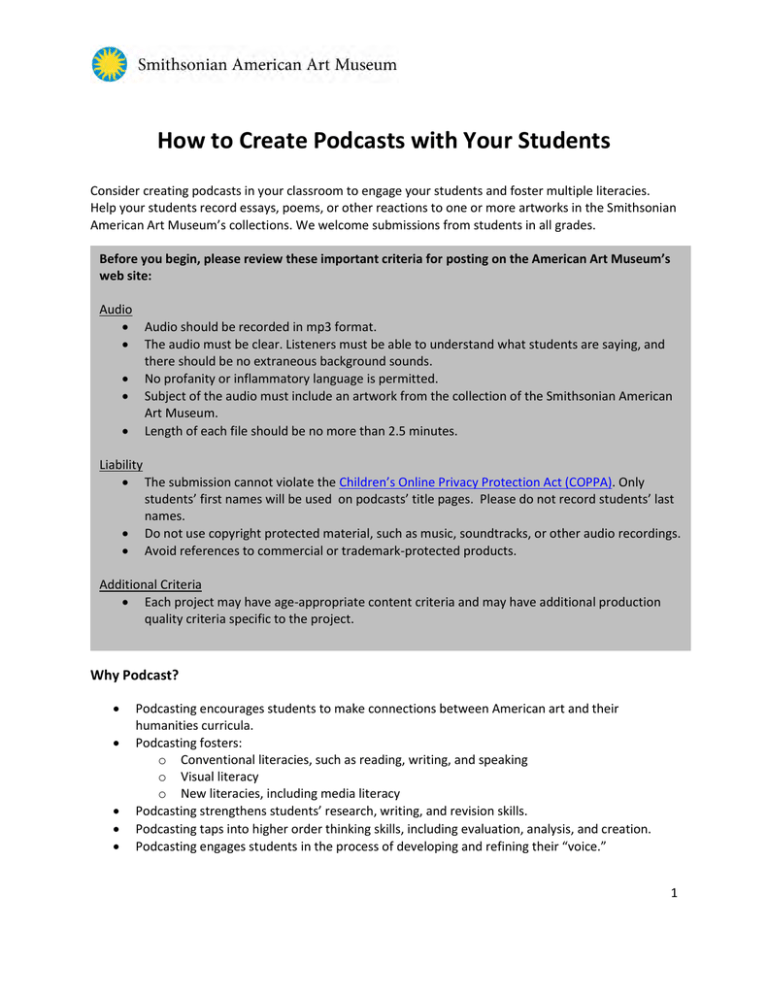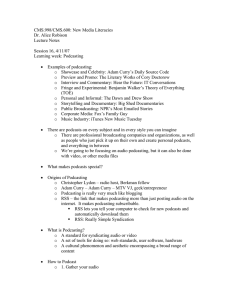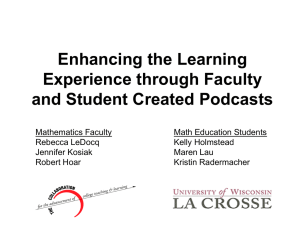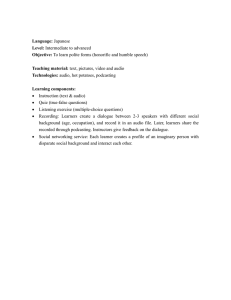How to Create Podcasts with Your Students
advertisement

How to Create Podcasts with Your Students Consider creating podcasts in your classroom to engage your students and foster multiple literacies. Help your students record essays, poems, or other reactions to one or more artworks in the Smithsonian American Art Museum’s collections. We welcome submissions from students in all grades. Before you begin, please review these important criteria for posting on the American Art Museum’s web site: Audio Audio should be recorded in mp3 format. The audio must be clear. Listeners must be able to understand what students are saying, and there should be no extraneous background sounds. No profanity or inflammatory language is permitted. Subject of the audio must include an artwork from the collection of the Smithsonian American Art Museum. Length of each file should be no more than 2.5 minutes. Liability The submission cannot violate the Children’s Online Privacy Protection Act (COPPA). Only students’ first names will be used on podcasts’ title pages. Please do not record students’ last names. Do not use copyright protected material, such as music, soundtracks, or other audio recordings. Avoid references to commercial or trademark-protected products. Additional Criteria Each project may have age-appropriate content criteria and may have additional production quality criteria specific to the project. Why Podcast? Podcasting encourages students to make connections between American art and their humanities curricula. Podcasting fosters: o Conventional literacies, such as reading, writing, and speaking o Visual literacy o New literacies, including media literacy Podcasting strengthens students’ research, writing, and revision skills. Podcasting taps into higher order thinking skills, including evaluation, analysis, and creation. Podcasting engages students in the process of developing and refining their “voice.” 1 Podcasting supports the goals of developing original and creative content, publishing work, and contributing to the larger conversation about artwork. "I would like to say thank you for allowing our students to participate in such an educational and engaging experience. Throughout this process, I was able to observe my students developing a willingness to write, revising their ideas with elaboration, and demonstrating their best effort." –6th grade special education teacher Designing Your Project Whether you teach art, social studies, writing, or another subject, here are some recommended steps: 1) Choose a topic you would like your students to explore through an artwork. Students can select works from the American Art Museum through our Search Collections web page – http://www.americanart.si.edu/collections/search/. 2) Create a rubric to measure students’ success. For tips on writing and recording a successful podcast, we recommend the pre-lesson below. You can also review our entire collection of student podcasts – http://americanart.si.edu/education/activities/podcasts/ – to find a model that works for you. 3) Instruct students to record their podcasts using a tool you have selected, or invite them to choose from a range of tools. You can use a variety of recording devices and audio software, from the internal microphone and sound recorder that come with a computer to a more advanced recording and editing program. Examples of the latter include GarageBand (available on most Macs), Audacity (a free download), and VoiceThread.com (free, but with a cost to export podcasts so double-check whether or not your school has a subscription). Podcasts should be no longer than 2.5 minutes. 4) Identify podcasts that meet your criteria and our guidelines. Email them to American Art (AmericanArtEducation@si.edu) to be polished and posted on the web site. If you send audio files, we will add the artwork. Be prepared to send the following information using a form provided by American Art Museum staff: School name City and state Student first name (provide last initial only if more than one student has the same first name) Grade level Subject area (e.g. language arts) Artwork title and artist 2 Suggested Pre-Lesson If your students are new to podcasting, we suggest using this activity to prepare them for your project: 1. Give each student a copy of our Ten Podcast Ingredients handout (see below) and review the list as a group. 2. Play an example of a student podcast for the class. You can select an example from the recommendations below or from the Museum’s Student Podcasting page – http://americanart.si.edu/education/activities/podcasts/. 3. Play the same example a second time and ask students to listen for the Ten Podcast Ingredients. Which ingredients can be identified? What did the student do well? Select additional examples to analyze for variety, so students can hear how each student’s personal “voice” helps to create diverse podcasting projects. Recommended examples: 1. Elementary School Language Arts Fired On, by Frederick Remington Joseph, 3rd Grade http://americanart.si.edu/education/activities/podcasts/drew/drew_2011/joseph_g_drew_201 1.m4v 2. Middle School Social Studies Washington Resigning His Commission, by Ferdinand Pettrich Charlie, 6th Grade http://americanart.si.edu/education/activities/podcasts/williamsburg/williamsburg_2008/charli e_w_williamsburg_2008.m4v 3. Middle School Language Arts Buffalo Hunt on the Southwestern Prairies, by John Mix Stanley Mackenzie, 6th Grade http://americanart.si.edu/education/activities/podcasts/williamsburg/williamsburg_2010/mack enzie_f_williamsburg_2010.m4v 4. High School Art History Interception, by Mark Tansey Cassie, 12th Grade http://americanart.si.edu/education/activities/podcasts/holton/holton_2008/cassie_m_holton_ 2008.m4v 3 Want to learn more about podcasting with your students? Hands-on podcasting experiences are offered during our Teaching the Humanities through Art summer teacher institutes at American Art – http://www.americanart.si.edu/education/dev/institutes/index.cfm. Attend a week-long institute in the nation’s capital, and join colleagues from across the country for an exciting exploration of the connections between art, technology, and your curricula. To find out more about how summer teacher institute alumni integrate podcasting into their curricula, read this article by Florida high school teacher Phyllis Merrill. “I had my students use podcasting to record and play back their essays so they could listen for errors in their writing. As they listened, I watched them correct their word usage, sentence structure, and organization of ideas. My students agreed that by hearing their compositions, they could take notice of errors in need of correction and identify areas in need of strengthening. They all look forward to repeating this experience as we proceed through the year.” –Phyllis Merrill, high school English teacher 4 Ten Podcast Ingredients 1. Choose an artwork from the collection of the Smithsonian American Art Museum. 2. Dedicate time to observing and researching the artwork. 3. Develop your personal “voice” and use it to write and edit a script before recording. 4. Generate an introductory “hook” to spark interest in your listeners. 5. Make observations and pose questions inviting listeners to look. 6. Provide nugget(s) of pertinent information about the artwork. 7. Consider mentioning a connection to a subject (e.g., historical or literary reference). 8. End with an interesting closing, leaving your listeners wanting more. 9. Speak clearly when recording and be mindful of ambient noise. 10. Aim for approximately two minutes of recording (a script of about 250 – 300 words, depending on the inclusion of other audio). 5


